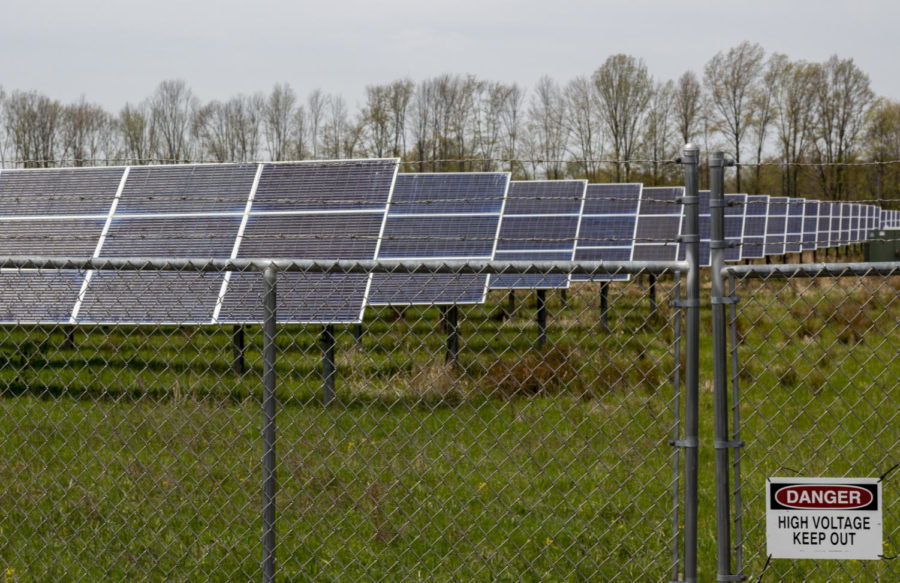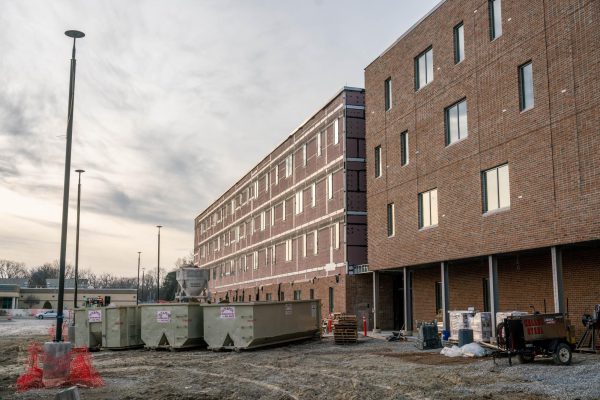College Will Invest in Geothermal Energy to Meet 2025 Carbon Neutrality Goal
The solar field, installed in 2012, provides 12 percent of Oberlin’s electricity. This summer, Oberlin will begin a four-year infrastructure project to develop a geothermal energy system, adding another carbon-free energy source.
This summer the College will begin a four-year infrastructure modernization project to reach its 2025 carbon neutrality goal. The project was announced in an April 19 email from President Carmen Twillie Ambar and includes replacing the College’s old heating infrastructure with geothermal energy, a carbon-free energy source; changing the district energy system to use hot water instead of steam; and upgrading buildings to be more energy-efficient.
The next phase of the project is estimated to cost the College $140 million. The project will be funded through federal grants and tax credits, as well as long-term capital borrowing. While this is a large investment for the College, the College hopes that it will help Oberlin move onto the frontline of clean energy technology.
“Our trustees made a bold decision that will not just fix the problem — it will show other large institutions across the country that it is possible to improve living and working conditions for students, faculty, and staff, while addressing a global challenge that touches all of us,” President Ambar wrote in her April 19 email to the College community.
Students agree that this project speaks to Oberlin’s commitment to being a leader in the fight against climate change. College fourth-year Stephan Ciulla, who has been involved with the project through the Green EDGE Fund, is excited about what the project means for Oberlin’s future.
“[The investment] is a financial declaration of who Oberlin is,” Ciulla said. “This project is not about cutting corners and getting there the fastest. It’s about how well it can be done in a way that is not only sustainable now but also is sustainable — financially, and environmentally — 50 to 100 years down the line.”
The project is the culmination of six years of careful planning and design by the College working not only with Oberlin’s carbon neutrality partner, Ever-Green Energy, but also with students, trustees, faculty, staff, and the City of Oberlin.
“One of the most essential pieces of this program has been maintaining the momentum of the importance of this program’s work, especially with the institution going through major changes during the last six years,” said Meghan Riesterer, assistant vice president of campus energy and sustainability and one of the leaders for the project.
However, student commitment to this undertaking, including the work of Ciulla and other members of the Green EDGE Fund, has helped keep the project moving.
The project’s most important decision was determining what the College should use as its carbon-free energy source. This process began in 2019, and while nine different low-carbon and carbon-free sources were considered, four sources — biomass, biogas, geothermal, and landfill gas — were deemed technically feasible and economically viable for the campus.
This March, the College decided that geothermal energy would be the best source after considering the environmental and the financial impact, as well as the ability to easily integrate it with existing systems. A geothermal source works by capturing the earth’s heat of 55 degrees Fahrenheit in vertical closed-loop wells, and then using heat exchangers to generate power. In order to use geothermal energy, Oberlin will be drilling and installing about 1100 geothermal wells north of the athletic fields.
There will be three major construction projects this summer. To prepare for the conversion to a hot water heating system, the utility infrastructure will be upgraded in several South Campus buildings: the Conservatory’s buildings, South Hall, Harvey House, Kade House, Price House, and Baldwin Cottage. Additionally, the Central Plant will be renovated so that the geothermal source can be implemented in the near future. South and West Campuses will also see new installation of water pipes to prepare for carbon-free heating and cooling.
While this project focuses on structural and internal changes, an important piece is making sure that the changes are visible to the students.
“We’ve been really intentional about messaging and why we are doing this project, which is making the campus carbon neutral,” Riesterer said. “When you pass by a construction site, we want students to understand that this is not just a capital project or construction project; it has intention and meaning behind it. Students can expect to see construction signs around campus, and the old pipes being replaced by new pipes.”
The construction will start on South Campus this summer and move clockwise until the project is complete. The projected timeline for the project plans for South Campus construction from summer 2021– summer 2022, West Campus from February 2021 – February 2022, East Campus from summer 2022 – 2024, and North Campus from summer 2022 – fall 2024.
With the completion of this infrastructure modernization project in four years, the College will be within 11 percent of its carbon neutrality goal. The last 11 percent includes emissions that are caused by the institution’s activities but not controlled by the institution, such as air travel to and from the College or staff commuting to work. This type of emissions are called Scope 3 emissions.
To accomplish this last leg of the project, the College will continue to evaluate innovative solutions.
“Together [faculty, staff, students, and trustees] have also used this project to create a comprehensive set of new opportunities for students, from experiential clean energy curriculum to future internships — and given that more than 300 of our admitted students have already expressed interest in environmental studies, that becomes an important new part of the Oberlin education and experience,” President Ambar wrote.







